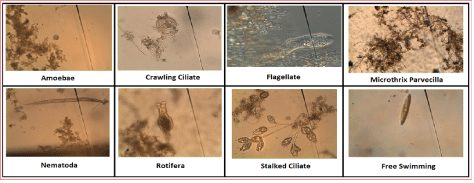
Figure 1: Different types of micro-organisms.


Mohamed A Halawa1* Ashraf EA Halawa2
1Lecturer of Sanitary and Environmental Engineering, Department of Civil Engineering, Higher Institute of Engineering, Cairo, Egypt*Corresponding author: Mohamed A Halawa, Lecturer of Sanitary and Environmental Engineering, Department of Civil Engineering, Higher Institute of Engineering, Cairo, Egypt, Tel: +20-1116484402; E-mail: mohamed.34911@yahoo.com
Reuse of treated wastewater in irrigation is a significant phenomenon in low-income countries because of polluted surface water sources. Water scarcity and population growth have led to find a lot of alternatives instead of fresh water. Approximately, seventy percent (70%) of world water are used for agricultural irrigation, so the reuse of Treated WasteWater (TWW) is an important for purposes such as agricultural and landscape irrigation. In this paper, the results obtained showed that using treated wastewater as irrigated water improved crop health compared with using fresh water as irrigated water. Irrigation with Secondary Treated Wastewater (STWW) has an impact on crop health. This paper showed the possibility of using STWW for irrigation of ornamental plants and it has a good effect on plant growth.
Wastewater irrigation; Treated wastewater; Secondary treated wastewater; Fresh water scarcity
Egypt faces a lot of water challenges led to the use TWW in agriculture [1]. The Nile River is the major water source in Egypt; it provides 55.5 × 109 m3 annually [2]. Population growth is the main reason for rising of water consumption. It is expected that domestic and industrial wastewater will be increased. Egypt is exhausted because of the fixed Nile water share [3]. Thus, the use of TWW is an important alternative water resource for irrigation. During recent years, reuse of TWW in agriculture has increased due to the increase in food demand. TWW can be used for irrigation instead of wastewater to decrease health risks [4].
The following studies present a literature review that reports the positive and negative effects of reuse of treated wastewater in agriculture. Elseoud AA, et al. [5] listed the main water management challenges facing Arab region as: water scarcity and sanitation facilities. WHO [6] estimated that about 10% of the population at world consumes food irrigated with wastewater. Reuse untreated wastewater causes adverse health effects because of viruses and bacteria. Reuse TWW has main challenges; social (public acceptance of wastewater reuse), management (crop selection and irrigation), human health risk, and environmental threats [7] and Elbana TA, et al. [8] reported that six Wastewater Treatment Plants (WWTPs) exist in greater Cairo. In Zenien wastewater treatment plant, and Kandil NF, et al. [9] evaluated soil and field crop pollution due to different irrigation water quality. Mok HF, et al. [10] investigated the suitability of reusing of TWW to irrigate wheat crops. The experiment was tested to use TWW under different cases; (W1) 100% fresh water, (W2) Mixed with 50% fresh water and TWW, (W3) mixed with 33% fresh water and 67% TWW and (W4) 100% TWW. The study concluded that using of treated wastewater (W3) in irrigation of agricultural crops under a monitoring system has economic feasibility
Agricultural irrigation is the most common reuse of treated or untreated wastewater to grow food. The essential risks of wastewater use in agriculture include soil pollution, salinity and toxicity. Wastewater quality data has been reported at WWTPs are mostly for treated effluent disposal such as; Biochemical Oxygen Demand (BOD), Chemical Oxygen Demand (COD), Suspended Solids (SS) that are of interest in water pollution control. The effluents of wastewater treatment plants usually contain organic chemicals. Such chemicals remaining in the water after the treatment process may cause hazards to human health [11]. Microbiological studies are considered as a source of information to avoid health risks. A lot of micro-organisms as shown in figure 1 and table 1 have been produced in 10 samples of different types of irrigated water. In a wastewater treatment plant, three different types of micro-organisms will be observed; bacteria (94%), Protozoa (5%) & Metazoa (1%). Bacteria need dissolved oxygen to be effective in the biological treatment system, so a lot of bacteria [12].

Figure 1: Different types of micro-organisms.
| Micro-Organisms | Types of irrigated water | ||
| Fresh water (FW) | Tertiary treatment (TTWW) | Secondary treatment (STWW) | |
| Count of micro-organisms for 10 samples | |||
| Microthrix Parvicella | 0 | 0 | 0 |
| Amoebae | 0 | 2 | 7 |
| Flagellate | 0 | 3 | 8 |
| Free-swimming Ciliates | 0 | 7 | 53 |
| Stalked ciliates | 0 | 14 | 247 |
| Paramecium | 0 | 1 | 11 |
| Rotifers | 0 | 4 | 27 |
| nematodes | 0 | 8 | 65 |
Table 1: Example of count worksheet for (10 samples) with different types of irrigated water.
Reuse untreated wastewater causes adverse health effects because of viruses and bacteria. Reuse of TWW in agriculture has increased due to the increase in food demand so this paper proposes to evaluate the use of two types of wastewater (Secondary treated wastewater-Tertiary treated wastewater) in Pritchardia beccariana, a species of palm tree that was planted in the gardens.
Zenien WWTP is the largest wastewater treatment plant in Egypt, was designed to treat a maximum design flow of 450,000 cubic meters per day of domestic wastewater. Secondary and tertiary treated wastewater was collected from Zenien WWTP in addition to third sample of fresh water as a control sample as shown in figure 2. The first sample represents the fresh water as a control sample, the second sample from Tertiary Treated Wastewater (TTWW) which was collected from the effluent water after the chlorination process and the third sample from Secondary Treated Wastewater (STWW) was collected from the effluent of the final settling tank. The collected samples were transferred to the laboratory of materials. These samples were analyzed for pH, Total Dissolved Solids (TDS), Total Suspended Solids (TSS), Biological Oxygen Demand (BOD5), and Chemical Oxygen Demand (COD). All these analyses were carried out according to the standard methods for the examination of water and wastewater as shown in table 2.
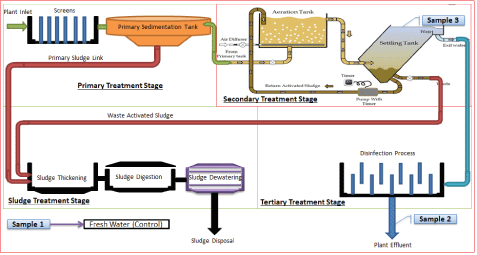
Figure 2: Stages of zenien wastewater treatment plant (WWTP).
| Sample No. | Type of Treatment | Chemical composition and physical properties of treated water | ||||||
| PH (Unit) | Temp (°C) | TSS (mg/l) | BOD (mg/l) | COD (mg/l) | TDS (mg/l) | Chloride (mg/l) | ||
| World health organization* | 6-8 | 24-28 | <2000 | <10 | <50 | <1000 | <2000 | |
| 1 | FW | 7.7 | 25.6 | 0 | 0 | 1 | 0 | 21 |
| 2 | TTWW | 7.3 | 26.5 | 1 | 1 | 8 | 2 | 18 |
| 3 | STWW | 7.4 | 26.6 | 11 | 10 | 24 | 22 | 87 |
Table 2: Chemical composition and physical properties of treated water.
The experiment was conducted with Pritchardia beccariana, a species of palm tree that was planted in the gardens of Egypt. Seeds of P. beccariana were planted in twelve plastic pots, each 12.5 cm in diameter and 20 cm high, filled with a mixture of sandy soil and clay soil as shown in figure 3. This study was conducted during the agricultural season of (August 2020-July 2021). The experiment was designed to divide plastic pots into three groups. Each group consisted of four plastic pots. The first group was irrigated with fresh water as a control sample (Sample 1). The second group was irrigated with tertiary treated wastewater (Sample 2) and the third group was irrigated with secondary treated wastewater (Sample 3) for one year. In this experiment, a lot of parameters were observed to evaluate; crop health (Stem length, number of stems, length & width of leaf and number of leaves) and human health (number of micro-organisms). The stem length was measured from the base to the top of plant. Figure 4 showed a lot of parameters were observed to evaluate crop health and the influence of different types of water on groups of Pritchardia beccariana.
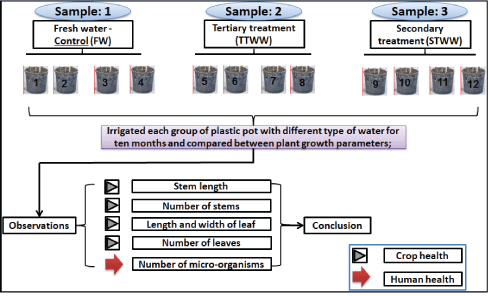
Figure 3: The Work Program Flow Chart.
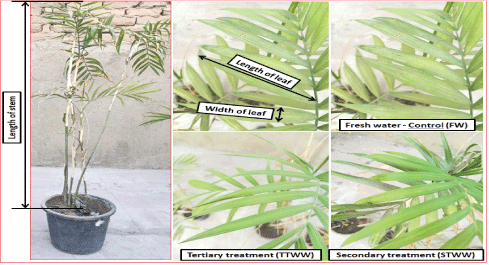
Figure 4: A lot of parameters were observed to evaluate crop health.
After one year, the crop health was observed as shown in figure 5 as a result of using different types of TWW. Irrigated plants with treated wastewater observed height growth and stem elongation bigger than the height growth and stem elongation of irrigated plants with fresh water. A control sample of irrigated plants with fresh water observed a height growth rate (average stem length) of 68 cm per year in the plastic pots during the experiment. Sample 2 of irrigated plants with TTWW observed a height growth rate (average stem length) of 88 cm per year in the plastic pots. Sample 3 of irrigated plants with STWW observed a height growth rate (average stem length) of 132 cm per year in the plastic pots during the experiment.
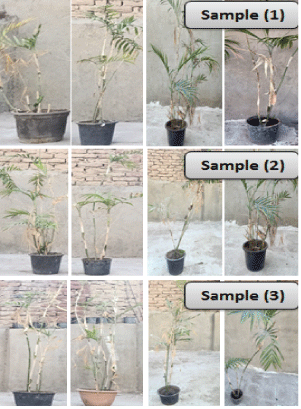
Figure 5: Influence of different types of water on groups of Pritchardia beccariana.
A lot of parameters were observed to evaluate crop health, such as; stem length, number of stems, length & width of leaf and number of leaves. In figure 6 the results obtained showed that using treated wastewater as irrigated water improved crop health compared with using fresh water as irrigated water. Irrigation with STWW has an influence of crop health; as the height of the plant increased by (29% & 94%) compared with irrigation with (FW & TTWW) respectively. In comparing the number of stems, irrigation with STWW recorded the number of stems more than irrigation with (FW & TTWW). This study also showed that the length of leaf in irrigation with STWW is longer than the length of the leaf in both irrigations (FW & TTWW) and observed that there was no influence on the width of the leaf. In comparing the number of leaves, Irrigation with TTWW recorded the number of leaves more than irrigations (STWW & FW) by (4.4% & 26.7%).
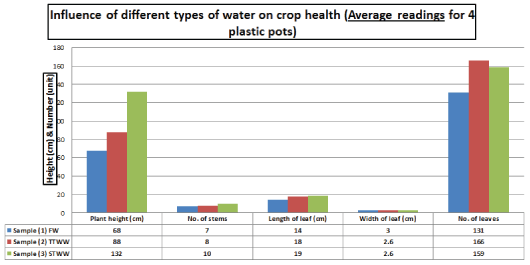
Figure 6: Influence of different types of water on crop health (Average readings for 2 plastic pots).
This experiment was designed to use two different types of treated wastewater (TTWW & STWW) to irrigate Pritchardia beccariana and compared the results of using treated wastewater with the results of using fresh water to irrigate the same plant. Twelve samples were used for this test; four samples were tested by using fresh water, another four samples were tested by using TTWW and the last four samples were tested by using STWW. The results of this experiment in irrigation of ornamental plants with treated wastewater, it was concluded that;
1. Using secondary treated wastewater (STWW) to irrigate ornamental plants such as; Pritchardia beccariana has a positive impact on crop health (stem length, number of stems, length & width of leaf and number of leaves) compared with tertiary treated wastewater (TTWW) and more economically.
2. Irrigation with STWW has a good influence on crop health compared with irrigation with (TTWW & FW).
The possibility of using secondary treated wastewater (STWW) for irrigation of ornamental plants has a good effect on plant growth.
Download Provisional PDF Here
Article Type: RESEARCH ARTICLE
Citation: Halawa MA, Halawa AEA (2022) Reuse Treated Wastewater in Irrigation-Review Specie of Palm Trees (Pritchardia Beccariana). Int J Water Wastewater Treat 8(2): dx.doi.org/10.16966/2381-5299.183
Copyright: © 2022 Halawa MA, et al. This is an open-access article distributed under the terms of the Creative Commons Attribution License, which permits unrestricted use, distribution, and reproduction in any medium, provided the original author and source are credited.
Publication history:
All Sci Forschen Journals are Open Access